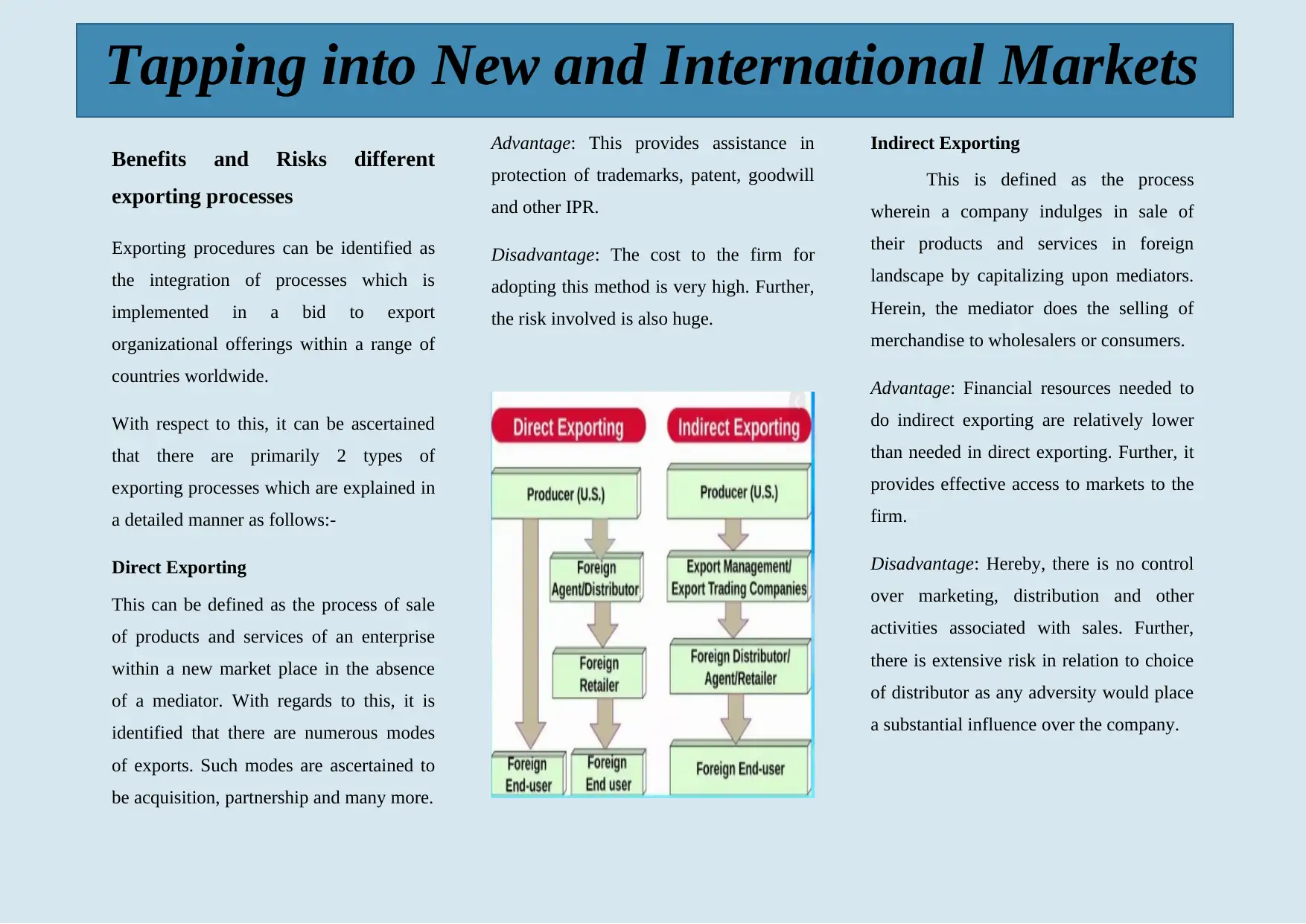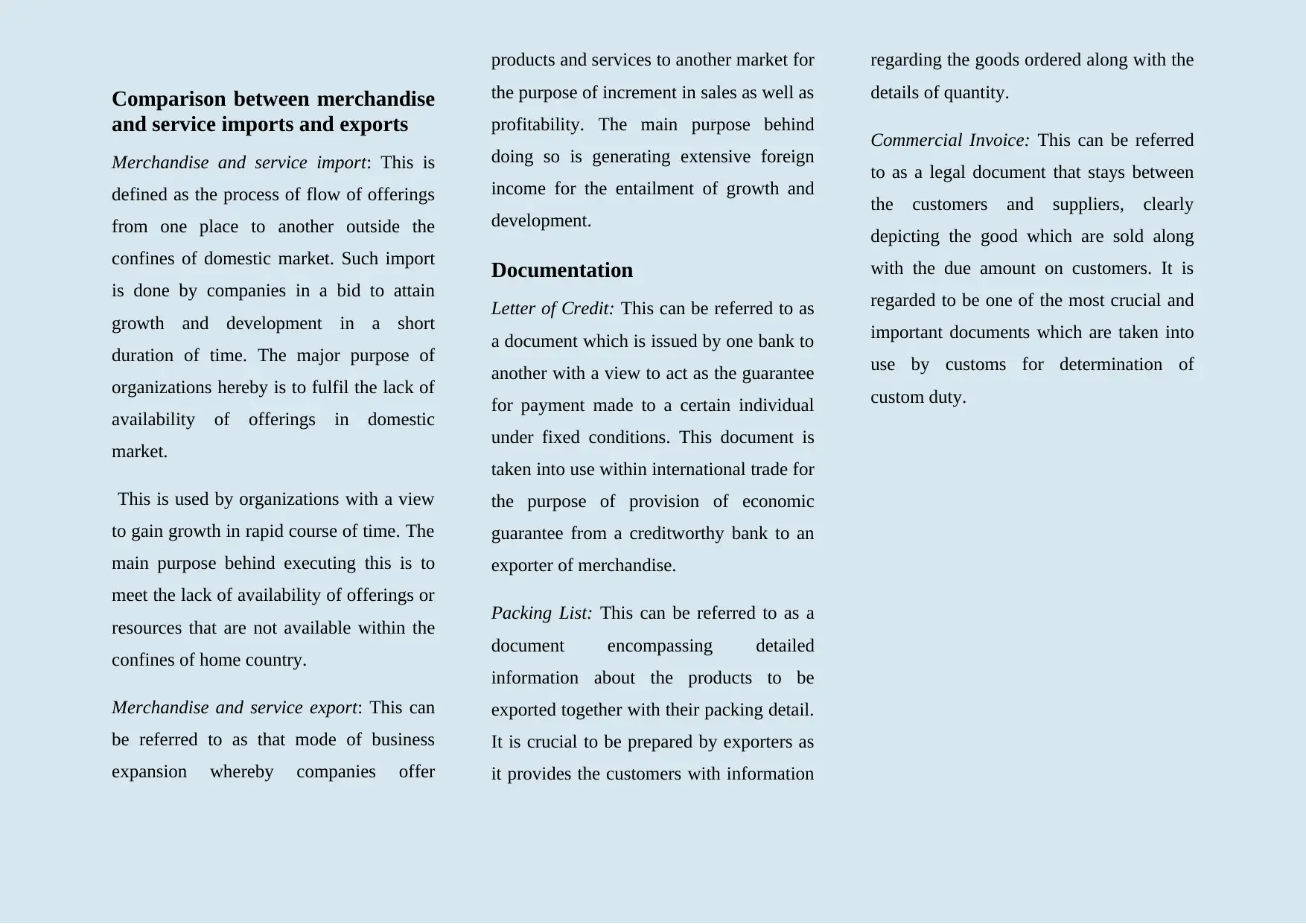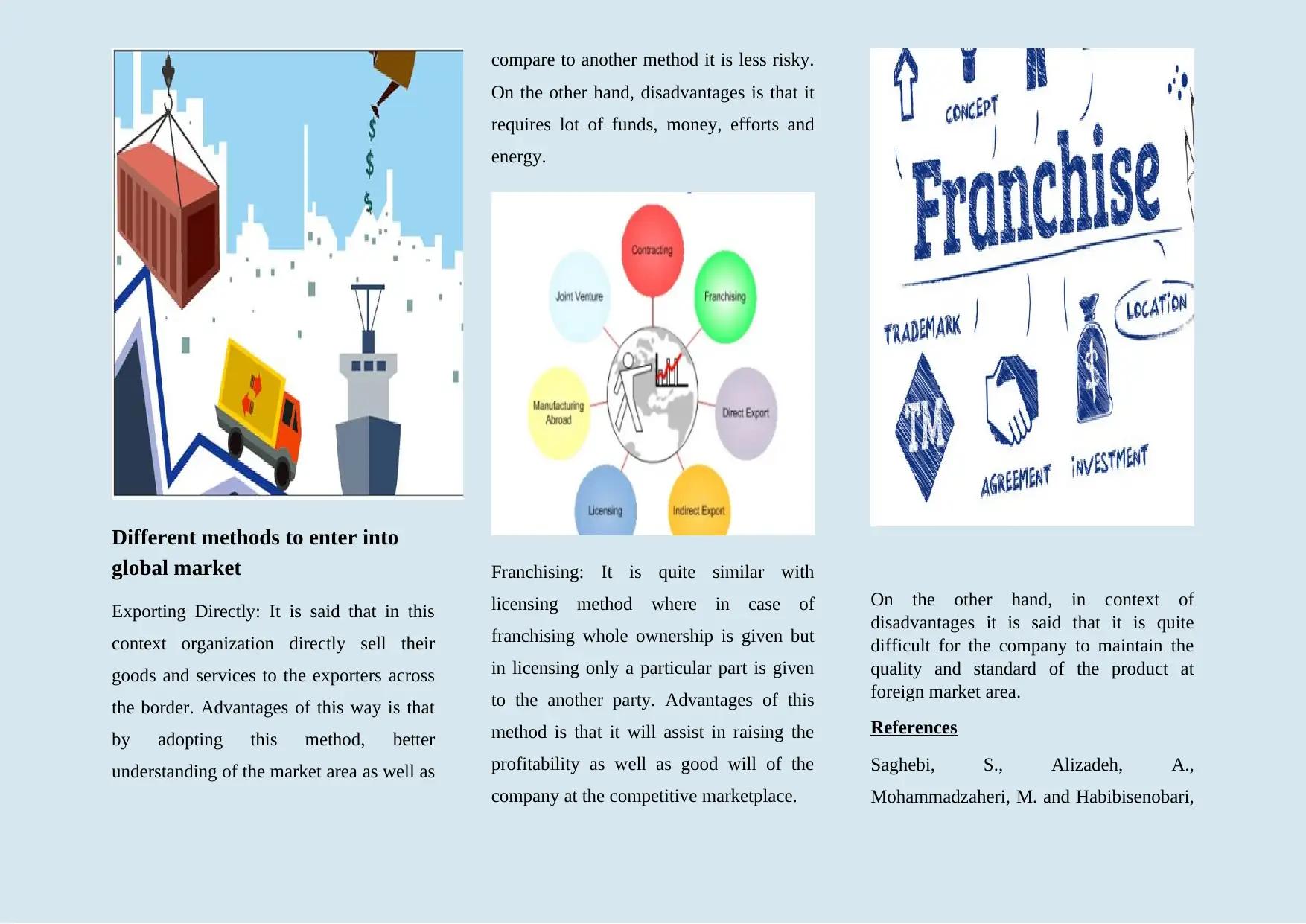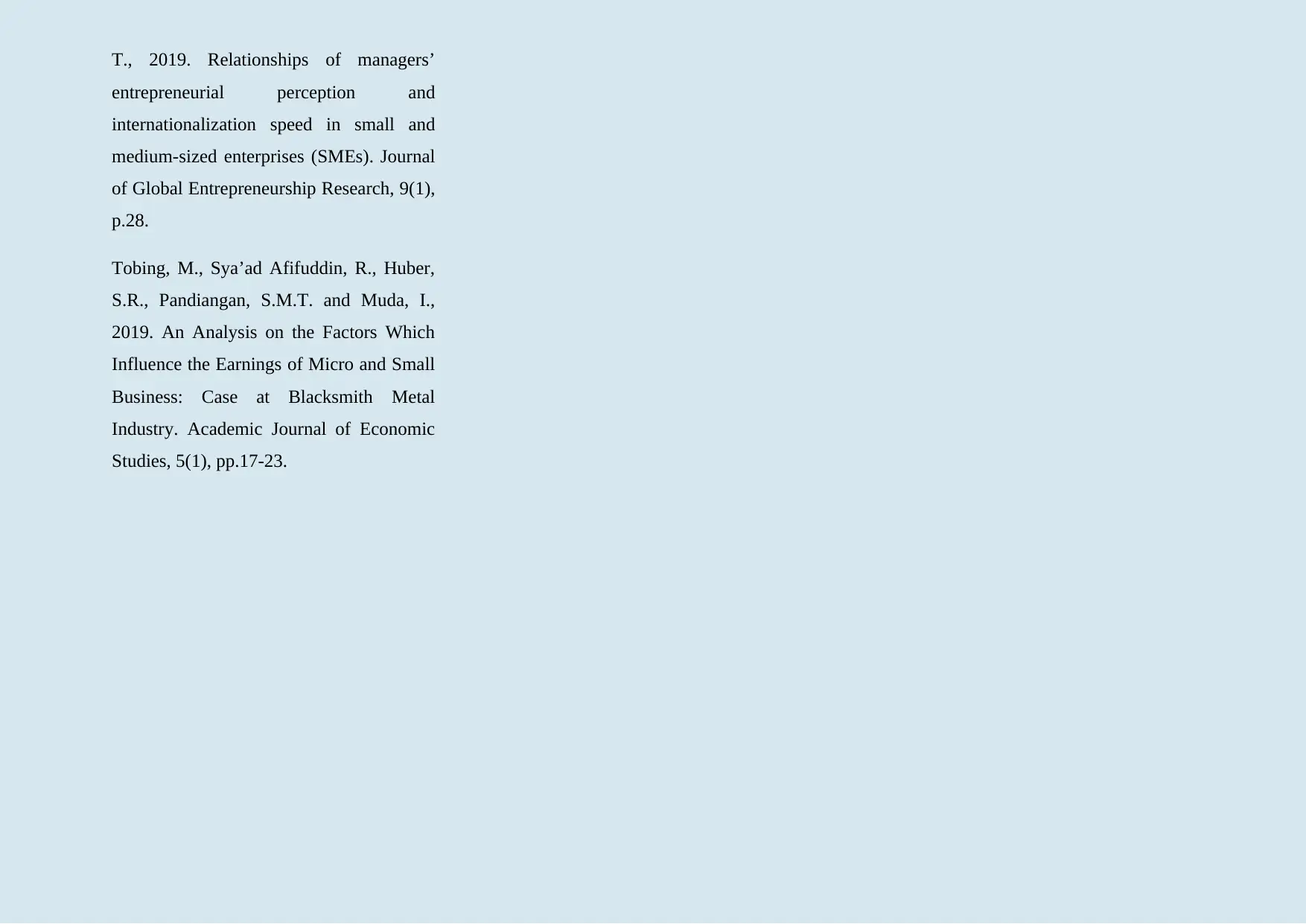Analyzing Exporting Processes, Global Market Entry, and Documentation
VerifiedAdded on 2023/01/13
|4
|921
|95
Report
AI Summary
This report examines various exporting processes, including direct and indirect exporting, and franchising, to facilitate international market entry. It details the advantages and disadvantages of each method, highlighting the associated risks and benefits. The report also explores essential documentation such as commercial invoices, packing lists, and letters of credit, crucial for smooth international trade operations. Furthermore, it provides a comparison between merchandise and service exports, offering insights into the financial resources, control, and market access aspects of each approach. The analysis draws on academic references to support the discussion on market understanding and profitability in the competitive global marketplace. The report aims to provide a comprehensive understanding of the strategic considerations involved in exporting and entering new international markets.

Benefits and Risks different
exporting processes
Exporting procedures can be identified as
the integration of processes which is
implemented in a bid to export
organizational offerings within a range of
countries worldwide.
With respect to this, it can be ascertained
that there are primarily 2 types of
exporting processes which are explained in
a detailed manner as follows:-
Direct Exporting
This can be defined as the process of sale
of products and services of an enterprise
within a new market place in the absence
of a mediator. With regards to this, it is
identified that there are numerous modes
of exports. Such modes are ascertained to
be acquisition, partnership and many more.
Advant
Advantage: This provides assistance in
protection of trademarks, patent, goodwill
and other IPR.
Disadvantage: The cost to the firm for
adopting this method is very high. Further,
the risk involved is also huge.
Indirect Exporting
This is defined as the process
wherein a company indulges in sale of
their products and services in foreign
landscape by capitalizing upon mediators.
Herein, the mediator does the selling of
merchandise to wholesalers or consumers.
Advantage: Financial resources needed to
do indirect exporting are relatively lower
than needed in direct exporting. Further, it
provides effective access to markets to the
firm.
Disadvantage: Hereby, there is no control
over marketing, distribution and other
activities associated with sales. Further,
there is extensive risk in relation to choice
of distributor as any adversity would place
a substantial influence over the company.
Tapping into New and International Markets
exporting processes
Exporting procedures can be identified as
the integration of processes which is
implemented in a bid to export
organizational offerings within a range of
countries worldwide.
With respect to this, it can be ascertained
that there are primarily 2 types of
exporting processes which are explained in
a detailed manner as follows:-
Direct Exporting
This can be defined as the process of sale
of products and services of an enterprise
within a new market place in the absence
of a mediator. With regards to this, it is
identified that there are numerous modes
of exports. Such modes are ascertained to
be acquisition, partnership and many more.
Advant
Advantage: This provides assistance in
protection of trademarks, patent, goodwill
and other IPR.
Disadvantage: The cost to the firm for
adopting this method is very high. Further,
the risk involved is also huge.
Indirect Exporting
This is defined as the process
wherein a company indulges in sale of
their products and services in foreign
landscape by capitalizing upon mediators.
Herein, the mediator does the selling of
merchandise to wholesalers or consumers.
Advantage: Financial resources needed to
do indirect exporting are relatively lower
than needed in direct exporting. Further, it
provides effective access to markets to the
firm.
Disadvantage: Hereby, there is no control
over marketing, distribution and other
activities associated with sales. Further,
there is extensive risk in relation to choice
of distributor as any adversity would place
a substantial influence over the company.
Tapping into New and International Markets
Paraphrase This Document
Need a fresh take? Get an instant paraphrase of this document with our AI Paraphraser

Comparison between merchandise
and service imports and exports
Merchandise and service import: This is
defined as the process of flow of offerings
from one place to another outside the
confines of domestic market. Such import
is done by companies in a bid to attain
growth and development in a short
duration of time. The major purpose of
organizations hereby is to fulfil the lack of
availability of offerings in domestic
market.
This is used by organizations with a view
to gain growth in rapid course of time. The
main purpose behind executing this is to
meet the lack of availability of offerings or
resources that are not available within the
confines of home country.
Merchandise and service export: This can
be referred to as that mode of business
expansion whereby companies offer
products and services to another market for
the purpose of increment in sales as well as
profitability. The main purpose behind
doing so is generating extensive foreign
income for the entailment of growth and
development.
Documentation
Letter of Credit: This can be referred to as
a document which is issued by one bank to
another with a view to act as the guarantee
for payment made to a certain individual
under fixed conditions. This document is
taken into use within international trade for
the purpose of provision of economic
guarantee from a creditworthy bank to an
exporter of merchandise.
Packing List: This can be referred to as a
document encompassing detailed
information about the products to be
exported together with their packing detail.
It is crucial to be prepared by exporters as
it provides the customers with information
regarding the goods ordered along with the
details of quantity.
Commercial Invoice: This can be referred
to as a legal document that stays between
the customers and suppliers, clearly
depicting the good which are sold along
with the due amount on customers. It is
regarded to be one of the most crucial and
important documents which are taken into
use by customs for determination of
custom duty.
and service imports and exports
Merchandise and service import: This is
defined as the process of flow of offerings
from one place to another outside the
confines of domestic market. Such import
is done by companies in a bid to attain
growth and development in a short
duration of time. The major purpose of
organizations hereby is to fulfil the lack of
availability of offerings in domestic
market.
This is used by organizations with a view
to gain growth in rapid course of time. The
main purpose behind executing this is to
meet the lack of availability of offerings or
resources that are not available within the
confines of home country.
Merchandise and service export: This can
be referred to as that mode of business
expansion whereby companies offer
products and services to another market for
the purpose of increment in sales as well as
profitability. The main purpose behind
doing so is generating extensive foreign
income for the entailment of growth and
development.
Documentation
Letter of Credit: This can be referred to as
a document which is issued by one bank to
another with a view to act as the guarantee
for payment made to a certain individual
under fixed conditions. This document is
taken into use within international trade for
the purpose of provision of economic
guarantee from a creditworthy bank to an
exporter of merchandise.
Packing List: This can be referred to as a
document encompassing detailed
information about the products to be
exported together with their packing detail.
It is crucial to be prepared by exporters as
it provides the customers with information
regarding the goods ordered along with the
details of quantity.
Commercial Invoice: This can be referred
to as a legal document that stays between
the customers and suppliers, clearly
depicting the good which are sold along
with the due amount on customers. It is
regarded to be one of the most crucial and
important documents which are taken into
use by customs for determination of
custom duty.

Different methods to enter into
global market
Exporting Directly: It is said that in this
context organization directly sell their
goods and services to the exporters across
the border. Advantages of this way is that
by adopting this method, better
understanding of the market area as well as
compare to another method it is less risky.
On the other hand, disadvantages is that it
requires lot of funds, money, efforts and
energy.
Franchising: It is quite similar with
licensing method where in case of
franchising whole ownership is given but
in licensing only a particular part is given
to the another party. Advantages of this
method is that it will assist in raising the
profitability as well as good will of the
company at the competitive marketplace.
On the other hand, in context of
disadvantages it is said that it is quite
difficult for the company to maintain the
quality and standard of the product at
foreign market area.
References
Saghebi, S., Alizadeh, A.,
Mohammadzaheri, M. and Habibisenobari,
global market
Exporting Directly: It is said that in this
context organization directly sell their
goods and services to the exporters across
the border. Advantages of this way is that
by adopting this method, better
understanding of the market area as well as
compare to another method it is less risky.
On the other hand, disadvantages is that it
requires lot of funds, money, efforts and
energy.
Franchising: It is quite similar with
licensing method where in case of
franchising whole ownership is given but
in licensing only a particular part is given
to the another party. Advantages of this
method is that it will assist in raising the
profitability as well as good will of the
company at the competitive marketplace.
On the other hand, in context of
disadvantages it is said that it is quite
difficult for the company to maintain the
quality and standard of the product at
foreign market area.
References
Saghebi, S., Alizadeh, A.,
Mohammadzaheri, M. and Habibisenobari,
⊘ This is a preview!⊘
Do you want full access?
Subscribe today to unlock all pages.

Trusted by 1+ million students worldwide

T., 2019. Relationships of managers’
entrepreneurial perception and
internationalization speed in small and
medium-sized enterprises (SMEs). Journal
of Global Entrepreneurship Research, 9(1),
p.28.
Tobing, M., Sya’ad Afifuddin, R., Huber,
S.R., Pandiangan, S.M.T. and Muda, I.,
2019. An Analysis on the Factors Which
Influence the Earnings of Micro and Small
Business: Case at Blacksmith Metal
Industry. Academic Journal of Economic
Studies, 5(1), pp.17-23.
entrepreneurial perception and
internationalization speed in small and
medium-sized enterprises (SMEs). Journal
of Global Entrepreneurship Research, 9(1),
p.28.
Tobing, M., Sya’ad Afifuddin, R., Huber,
S.R., Pandiangan, S.M.T. and Muda, I.,
2019. An Analysis on the Factors Which
Influence the Earnings of Micro and Small
Business: Case at Blacksmith Metal
Industry. Academic Journal of Economic
Studies, 5(1), pp.17-23.
1 out of 4
Related Documents
Your All-in-One AI-Powered Toolkit for Academic Success.
+13062052269
info@desklib.com
Available 24*7 on WhatsApp / Email
![[object Object]](/_next/static/media/star-bottom.7253800d.svg)
Unlock your academic potential
Copyright © 2020–2025 A2Z Services. All Rights Reserved. Developed and managed by ZUCOL.




